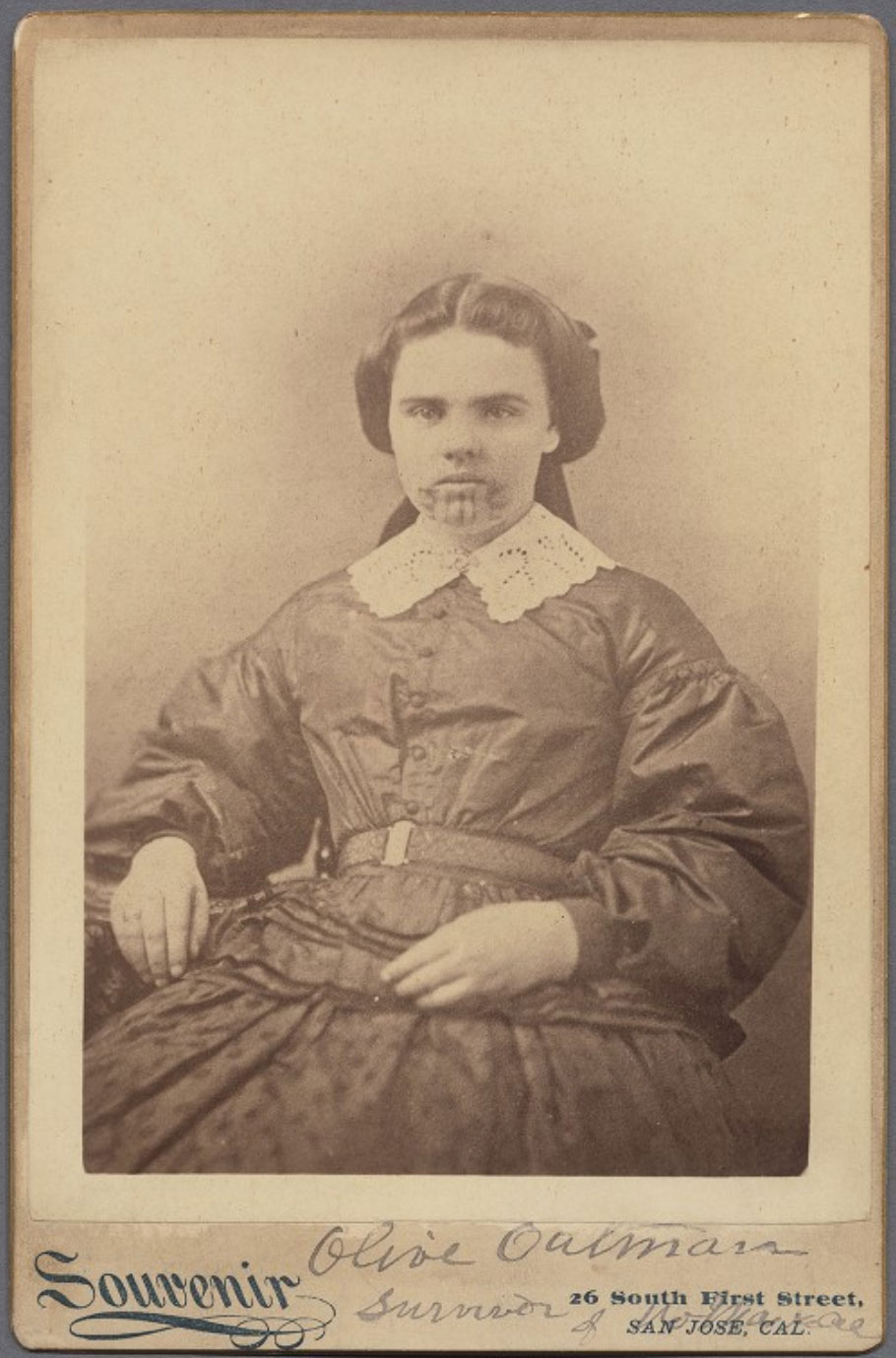In 1857, Royal Byron Stratton finished penning his new book. Little did he know that it was about to become a best-seller. It was co-written with a man named Lorenzo Oatman and, most importantly, with his sister Olive. Its title: Life among the Indians: or, The Captivity of the Oatman Girls Among the Apache & Mohave Indians. The Oatman Girls were Olive Oatman and her little sister Mary Ann, who died while living with Mohave natives in the American West. In the following years, Olive travelled all around the United States to tell her curious story through a series of conferences in promotion for Stratton’s book. The highlight of the show was the odd tattoo that marred her chin.

Olive Oatman’s story begins in 1850. She was twelve, perhaps thirteen, when her family left Illinois for the Colorado River Delta with other Mormons. It was a difficult trip, riddled with tensions. Near the Gila River, the Oatman family separated with the rest of the group and advanced towards Fort Yuma, on the state border between Arizona and California. But, on the 18th of February 1851, the convoy was attacked by Yavapai natives. Seven people were killed, including Olive’s parents; Lorenzo was left for dead, Olive and Mary Ann were captured. One year later, Olive and Mary Ann were traded with Mohave natives for horses, blankets, and other trinkets. But the Mohaves chose to adopt them. They tattooed them on their chins: it was, in their culture, a passport to the afterlife. Mary Ann died in a winter of famine, in 1853 or perhaps in 1854. Olive’s stay lasted until the 22nd of February 1856, when she was repatriated to Fort Yuma in exchange for horses, blankets, and pearls. Was Olive’s stay with the Mohaves forced? Could she have left earlier? The question is still highly debated among historians. But one thing is sure: Olive’s body was forever marked by her experience. Her chin tattoo made her significantly different from other white American women.

After coming back to her normal life and being reunited with her brother, Olive seemingly wasted no time before communicating on this tragedy. After all, the stage was set for her: the Oatman massacre had been covered by the press, everybody was expecting her to tell her story. On the 19th of April 1856, newspaper The Star published an article from an interview with Olive: it retold her experience while emphasising the kindness and generosity of the Mohave chief. In June, Olive told her story in the San Francisco Daily Evening Bulletin, this time using the first person. She met the young Reverend Stratton in Gassburg, the following summer. Therefore, the book idea was born. The result differed greatly from the stories Olive told the press, though: there were exaggerations, omissions, and subtle modifications to make the book fit in the established literary genre of the ‘captivity tales’. This genre consisted of autobiographies, and it had been quite successful since the beginning of the conquest of the West. Narrating the lives of individuals, often women, among ‘Indians’ was a perfect occasion to develop themes related to redemption, faith, barbarism, and alterity. In a developing nation, that meant inventing the common cultural identity of white Americans. Therefore, the Mohaves had to be demonised to become dangerous-looking “Others”.

The first print of 5000 copies sold out in three weeks. For its second edition of 6000 copies, the book was retitled Captivity of the Oatman Girls and Olive’s tattoo was used as a frontispiece. In 1858, 26,000 new copies were printed in New York. During Olive’s promotional tour, her tattoo was displayed as a direct proof of the book’s tale as she read chosen extracts of the text. As a tattooed phenomenon, Olive Oatman became a distant heir to James F. O’Connell and Joseph Kabris. But, most importantly, she became a precursor to ‘modern’ tattooed phenomena like Nora Hildebrandt of Irene Woodward. After all, Irene’s shows were built on an oddly familiar tale of caricatured ‘Indians’ and forced captivity… Everything was tailored to follow Olive’s example, from the tattooed mark to the storytelling, the gross exaggerations, and the sale of photographs that still circulate among collectors today. It was quite the successful formula, too. Stratton’s book sold 30,000 copies, and gave Olive Oatman the means necessary to enrol in a preparatory school, then to enrol in university. In 1864, Olive Oatman met John Brant Fairchild near Detroit, and they married shortly after. Rumour says she bought and burned every copy of the Captivity of the Oatman Girls he could lay his hand on, in order to offer a new life to his bride. She died of cardiac complications in 1903. She was survived by pictures of her tattoo, but also by her inspiring life story. The popular TV series Hell on Wheels even referenced Olive’s story between 2011 and 2016: Eva, played by actress Robin McLeavy, displayed a familiar tattoo on her chin…
Illustrations
Loryea & Macaulay, “Olive Oatman”, cabinet card, c. 1860 (Wikimedia – Public domain). Benjamin F. Powelson, “Olive Oatman”, calling card, s. d. (Wikimedia – Public domain). Benjamin F. Powelson, “Olive Oatman”, silver print, c. 1863, Washington, National Portrait Gallery, Smithsonian Institution (Wikimedia – Public domain). Further reading Kathryn Zabelle Derounian-Stodola, ‘The Captive and Her Editor: The Ciphering of Olive Oatman and Royal B. Stratton’, Prospects, 23, 1998, pp. 171–192. Margot Mifflin, The Blue Tattoo. The Life of Olive Oatman, Lincoln, University of Nebraska Press, 2011. Amelia K. Osterud, The Tattooed Lady. A History, Lanham, Boulder, New York et Londres, Taylor Trade Publishing, 2014. Jennifer Putzi, Identifying Marks. Race, Gender and the Marked Body in Nineteenth-century America, Athens et Londres, University of Georgia Press, 2006.